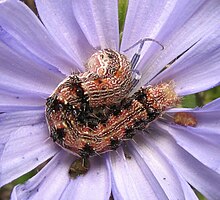Heliothinae
| Heliothinae | |
|---|---|

| |
| Heliothis peltigera | |
| Scientific classification | |
| Domain: | Eukaryota |
| Kingdom: | Animalia |
| Phylum: | Arthropoda |
| Class: | Insecta |
| Order: | Lepidoptera |
| Superfamily: | Noctuoidea |
| Family: | Noctuidae |
| Subfamily: | Heliothinae Boisduval, 1828 |
| Genera | |
|
See text | |

Heliothinae is a small, cosmopolitan subfamily of moths in the family Noctuidae, with about 400 described species worldwide. It includes a number of economically significant agricultural pest species, such as Helicoverpa armigera and Helicoverpa zea.
Taxonomy
The subfamily has been studied extensively. Important works include studies by Hardwick (1965 and 1970) and Matthews (1988).
Distribution and diversity
Heliothinae is a cosmopolitan[1] subfamily of around 400 species.[2] Its species thrive in hot, dry regions of the world,[1] and the subfamily has its highest species diversity in seasonally-arid tropics and subtropics, such as those found Australia, sections of Asia, the southwest region of the United States, and Africa.[2]
Larvae
The subfamily includes both specialist species, of which the larvae feed on only a limited range of plants, and polyphagous generalist species.[3]
The subfamily contains several agricultural pests, including Helicoverpa armigera, Helicoverpa assulta, Helicoverpa zea, Helicoverpa punctigera and Heliothis virescens.[3]
Genera
The subfamily includes the following genera:
- Adisura Moore, 1881
- Aedophron Lederer, 1857
- Australothis Matthews, 1991
- Baptarma Smith, 1904
- Chloridea Duncan & Westwood, 1841
- Chazaria Moore, 1881
- Derrima Walker, 1858
- Eutricopis Morrison, 1875
- Hebdomochondra Staudinger, 1879
- Helicoverpa Hardwick, 1965
- Heliocheilus Grote, 1865
- Heliolonche Grote, 1873
- Heliothis Ochsenheimer, 1816
- Heliothodes Hampson, 1910
- Melaporphyria Grote, 1874
- Micriantha Hampson, 1908
- Microhelia Hampson, 1910
- Periphanes Hübner, 1821
- Protadisura Matthews, 1991
- Psectrotarsia Dognin, 1907
- Pyrocleptria Hampson, 1903
- Pyrrhia Hübner, 1821
- Rhodoecia Hampson, 1910
- Schinia Hübner, 1818
- Stenoecia Warren, 1911
- Timora Walker, 1856
Selected former genera
- Erythroecia Hampson, 1910
- Masalia Moore, 1881
- Thyreion Smith, 1891
Text is available under the CC BY-SA 4.0 license; additional terms may apply.
Images, videos and audio are available under their respective licenses.
